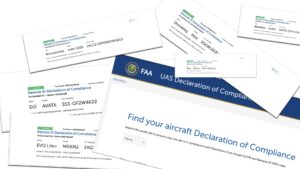Remote ID for drones is coming to the United States. The production compliance date for manufacturers is September 16, 2022 and the operational compliance date is September 16, 2023. The rules themselves became effective on April 21, 2021. Part of getting to drones that work under the rules is having a means of compliance (MOC) approved by the FAA. Those wishing to have their MOC evaluated can submit it to the Declaration of Compliance (DOC) site.
All of this and a lot more was recently discussed at the ASTM F3411 Remote ID Workshop. ASTM is the American Society for Testing and Materials and they work with the help of industry experts to produce consensus standards. These standards are the result of many working group meetings, discussions, revisions, and voting by members to produce standards that can be adopted around the world.
The workshop included a list of government and industry speakers with the opening remarks coming from Brian Wynne of AUVSI. Others contributing included Ben Walsh from FAA Flight Standards, Gabe Cox from Intel and the Chairman of the Remote ID Workgroup, Dylan Amerson from Mississippi State, and Sam Sadeghi from FAA Aircraft Certification.
There was a good overview of the regulatory process up to this point as well as a look at the path forward from Ben. Generally speaking, an MOC must meet the minimum performance requirements laid out in Part 89. Once an MOC is accepted, notice will be posted in the Federal Register and the expectation is an MOC will be approved in approximately 6 months, so manufacturers will have around 12 months before the production compliance date.
Gabe discussed the work group’s progress in updating the current standard to meet the requirements from the FAA’s final rule. There was also a dive into the types of broadcast via Bluetooth 4, 5, Wi-fi NAN, and Wi-Fi Beacon. There was a conceptual discussion of how session IDs could be implemented, but not in a prescriptive way. It seems the encryption key will be an interesting topic going forward. Overall, the working group team is confident that their existing standard will be ready for submission as an MOC soon.
Another important discussion point came around testing, which manufacturers will need to do for DOC submission. The ASTM version lays out bench testing, flight testing, and survey point accuracy. So, testers can use known survey points, that are in high supply, as check values in their work. In order to be approved, manufacturers will have to show they meet the performance requirements for frequency of message sending, message elements, and that the elements fall within the established distances.
Next up was Dylan Amersen from ASSURE to discuss their first field testing. They used multiple devices running an open drone ID software to test performance of both WiFi and BT versions. This is just preliminary testing, but the results pointed toward messages working out to 3 kilometers in some instances. More studying will have to be done, as there was some packet loss along the way (meaning not all the messages that got sent were received by devices), but it is good to see a first pass showing that the broadcast system can cover a large area in the right environment.
Rounding out the discussion before overall Q&A was Sam Sadeghi from the FAA talking about DOCs. Essentially, if you are manufacturing a drone to be flown over people, that requires Remote ID, you will need a DOC for review and acceptance by the FAA. The DOC process is fully digital and can be started via the FAA Website. The process is focused around the applicant accepting a number of declarations and acknowledgments rather than a need for remote ID documentation. Another interesting piece of the DOC process is that the FAA may physically audit facilities to ensure that the rules are being adhered to by the manufacturer. Approved DOCs will be listed along with the approved MOCs on the website.
Finally, the event finished with a general Q&A. Everyone was very interested in the performance differences between WiFi and Bluetooth 4 and 5. So, it will be enlightening to see where testing shakes out on the different technology implementations for an approved MOC. From a service provider perspective, we are really looking forward to an approved method so we can unlock some of those expanded operations everyone has been talking about for years.
All-in-all, for us, these kinds of discussions are reassuring that progress is being made in the Remote ID space. Kenji has enjoyed participating in the Remote ID ARC, the ASTM Working Group on Remote ID, as well as the DAC taskings around Remote ID. We will continue to participate in the drafting, the conversations around it, and the implementation as well. We are also very excited and honored to be participating in the just announced BVLOS Aviation Rulemaking Committee.


